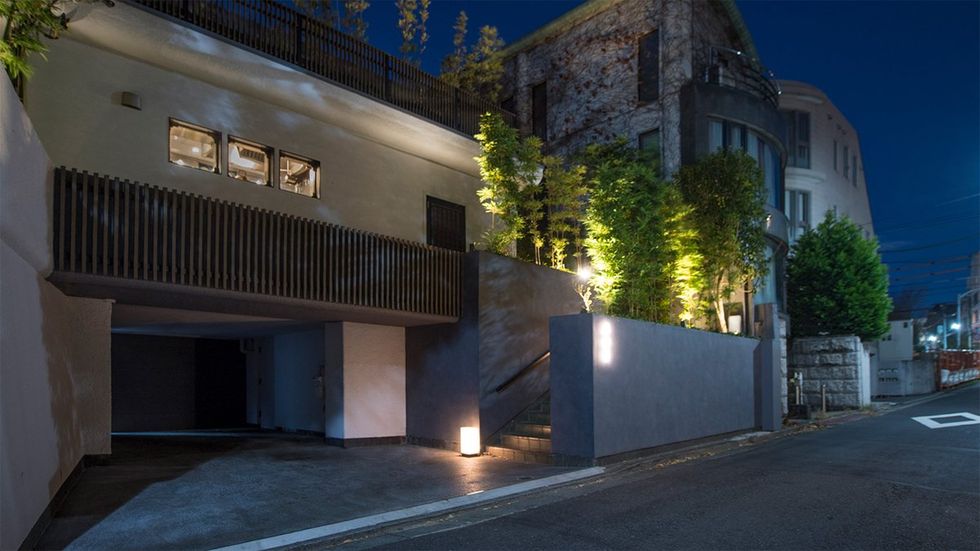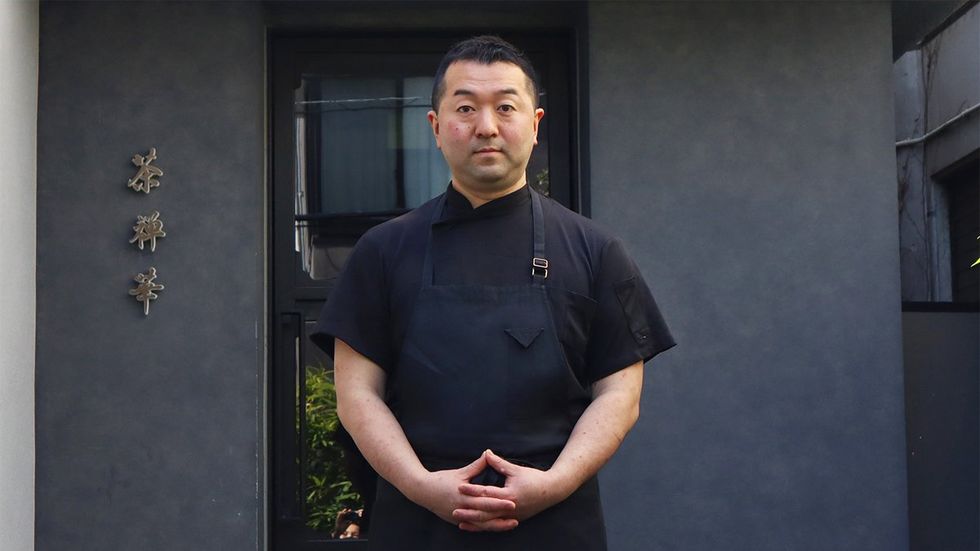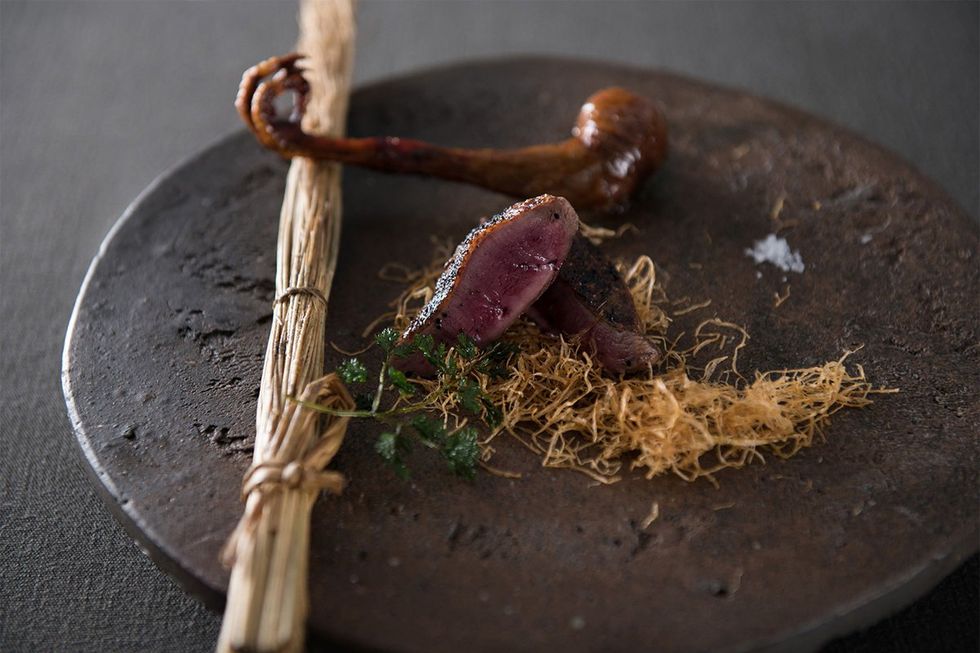

By Maggie Hiufu Wong, CNN
(CNN) -- Inside a dimly lit dining room, chef Tomoya Kawada of Sazenka is drawing a yin-yang diagram on a notepad as he explains his dreams for the distant future.
"World peace through food," he says.
Such words could easily be dismissed as idealistic hyperbole. But coming from Kawada, they sound almost reassuring -- and even attainable.
After all, this Japanese chef has achieved a feat no other restaurateur has before; he's created the world's only three-Michelin-star Chinese restaurant in a non-Chinese-speaking city. Not an easy task in the tightly guarded world of Chinese kitchens.
Chinese techniques infused with Japanese spirit

Set inside a former diplomat's house in a quiet upscale residential district, Sazenka's rise was swift. It was awarded two stars by the Michelin Guide in 2017 -- the same year it opened. Another star was added in 2020 and it has held on to all three in the years since.
To highlight just how impressive it is, it's worth nothing there are only seven other other Chinese restaurants in the world with three Michelin stars, and those are in Hong Kong, Macao, Taipei and Beijing.
The Tokyo restaurant was also named the 11th best restaurant in Asia's 50 Best Restaurants Awards in 2022, the second highest ranking Chinese restaurant on the list.
"I'm not there yet," the humble chef says of his achievements.
"It's only been six years. I'm sure we can make even better food, provide better service and make our customers more satisfied."
The team has multiple daily meetings as part of efforts to achieve those goals.
"Unfortunately, I'll probably not feel satisfied with the results until I die," says Kawada. "But we're growing and we're happy. It's like climbing a mountain -- we reach one summit and something else begins. But when we look back, I still think it was fun when we were climbing."
The restaurant's poetic name, Sazenka, is made up three words that mean tea, zen and Chinese. The restaurant's 11-course feast, excluding small bites, pairing teas and desserts, feels more like a mindful kaiseki experience than a traditional Chinese banquet. The cost? About $450 per person.
It begins with a bowl of somen noodles served in a mix of clear broth and tea oil in a blue-and-white porcelain stem cup, and ends with a sweet rice ball floating in a mild tea soup.
The menu's regional Chinese dishes, from Cantonese char siu (honey-glazed roast pork) to Sichuan pepper pigeon, are infused with a uniquely Japanese touch.
Why Chinese food?

For Kawada, the menu he's created for Sazenka is a childhood dream come true. His love for Chinese food took seed when he was just five years old, after his parents took him to a Chinese restaurant in Japan's Tochigi prefecture.
"I vividly remember that moment, when I was attracted by the beauty and the deliciousness of Chinese food," he says.
"There were dishes named bang bang chicken, mapo tofu or yun bai rou (cloudy pork slices). I was fascinated by their beauty. I could see the magnificent Chinese landscape in the food.
"I was so impressed by it that I decided I would become a Chinese chef in the future."
At 18 years old, he got a job inside the kitchen of Azabu Choko, a now-closed Sichuanese restaurant in Tokyo. He worked there for a decade before switching to Japanese cuisine and training under chef Seiji Yamamoto of RyuGin for five years.
But over the years, he visited China often to see the landscapes and deepen his understanding of the cuisine.
In 2017, he began to develop his own version of Chinese cuisine and Sazenka was born.
"There is a Japanese phase called Wakon-Kansai (Japanese spirit and Chinese talent)," Kawada says, when asked to define his cuisine.
"Sazenka's food is based on Sichuan cuisine with a Japanese spirit and a Chinese sensibility."
Wonton soup with a Japanese twist
The set-course menu is filled with showstoppers, all highlighting the chef's meticulous Chinese and Japanese cooking techniques.
The Sichuan Pepper Pigeon is prepared in two ways -- its thighs are cooked to crispy perfection in the Cantonese style, while the breast is given the Japanese yakitori treatment -- skewered and grilled.
The Sichuan-inspired dish of Cloudy Pork Slices features beautifully marbled pork layered with thin eggplant slices cut into the shape of feathers.
The Jellyfish Salad is delicately sliced and plated in a small bowl carved out of a Japanese sudachi citrus.
But out of all of Sazenka's rich and expressive dishes, Kawada chooses the humblest of them all to represent his restaurant: the pheasant soup, inspired by Hong Kong's wonton soup, featuring one floating pork dumpling in clear broth.
"Hong Kong's premium stock is amazingly delicious. I always wondered what would happen if I tried to express the taste of Japanese stock in Chinese cuisine," says Kawada.
To make the "simple soup," as he calls it, the pheasant's bones need to be pounded and soaked in water overnight. They're then boiled in high heat till the blood comes out and is removed. The remaining bones are then boiled down for about four hours.
The broth will need to rest for another day before minced pheasant meat, Jinhua-cured ham, kelp, green onions, ginger, 15-year-old Shaoxing wine, salt and pepper are added to season the clear stock.
"The moment you put it in your mouth, the taste is nothing striking but very gentle," says the chef.
"But gradually, the deliciousness comes. The deepness of this deliciousness is a strength of Japanese cuisine. The spirit of Japanese cuisine is a dish that makes you think, 'I really enjoyed that pheasant soup' only three days later. This pheasant soup is the world of Japanese cuisine represented in one bowl."
"It's not fusion but harmony"

The soup is also the perfect illustration of Sazenka's Wakon-Kansai philosophy, which has nothing to do with re-creating authentic Chinese dishes in Japan.
"I'd always thought that authentic cuisines from their original places are the best. But I think the development of a culture is only possible when it travels. So now, I think creating a cuisine, be it Sichuan or Japanese, that makes people feel comfortable is an outstanding achievement," says Kawada.
For him, eating is more than just an activity but "a beautiful way to communicate peace."
In his view, it all goes back to that yin-yang Taiji symbol.
"If Japanese cuisine is black and Chinese cuisine is white, the fusion of the two will make a gray circle," he says, noting that instead, the two cuisines should co-exist like the black and white dots in the Yin-Yang diagram.
"It isn't fusion but harmony, which is made up of two Chinese characters -- cho and wa (mix and together) -- without erasing the goodness of Japanese cuisine and Chinese cuisine in each other."
He points to Japanese food as being a cuisine that has achieved this aim by incorporating the culinary techniques and ingredients of various cultures from all over the world.
"I think the idea of Wakon-Kansai is wonderful. It shows how people strongly believed that Japanese and Chinese cultures should get along with each other more than 1,000 years ago, and that we should respect each other's good points."
Though the concept of Wakon-Kansai originated in the Heian period (794-1185), he says it still applies to many relationships in the world today.
"Cooking is about a consideration for the earth and it's also about the relationship between countries," says Kawada.
"I hope Sazenka can be seen in this way as a symbol of world peace by getting along through food. That's the idea I have when I am approaching my cooking."
The-CNN-Wire
™ & © 2023 Cable News Network, Inc., a Warner Bros. Discovery Company. All rights reserved.
One of the Best Chinese Restaurants in the World Is in Japan

By Maggie Hiufu Wong, CNN
(CNN) -- Inside a dimly lit dining room, chef Tomoya Kawada of Sazenka is drawing a yin-yang diagram on a notepad as he explains his dreams for the distant future.
"World peace through food," he says.
Such words could easily be dismissed as idealistic hyperbole. But coming from Kawada, they sound almost reassuring -- and even attainable.
After all, this Japanese chef has achieved a feat no other restaurateur has before; he's created the world's only three-Michelin-star Chinese restaurant in a non-Chinese-speaking city. Not an easy task in the tightly guarded world of Chinese kitchens.
Chinese techniques infused with Japanese spirit

Set inside a former diplomat's house in a quiet upscale residential district, Sazenka's rise was swift. It was awarded two stars by the Michelin Guide in 2017 -- the same year it opened. Another star was added in 2020 and it has held on to all three in the years since.
To highlight just how impressive it is, it's worth nothing there are only seven other other Chinese restaurants in the world with three Michelin stars, and those are in Hong Kong, Macao, Taipei and Beijing.
The Tokyo restaurant was also named the 11th best restaurant in Asia's 50 Best Restaurants Awards in 2022, the second highest ranking Chinese restaurant on the list.
"I'm not there yet," the humble chef says of his achievements.
"It's only been six years. I'm sure we can make even better food, provide better service and make our customers more satisfied."
The team has multiple daily meetings as part of efforts to achieve those goals.
"Unfortunately, I'll probably not feel satisfied with the results until I die," says Kawada. "But we're growing and we're happy. It's like climbing a mountain -- we reach one summit and something else begins. But when we look back, I still think it was fun when we were climbing."
The restaurant's poetic name, Sazenka, is made up three words that mean tea, zen and Chinese. The restaurant's 11-course feast, excluding small bites, pairing teas and desserts, feels more like a mindful kaiseki experience than a traditional Chinese banquet. The cost? About $450 per person.
It begins with a bowl of somen noodles served in a mix of clear broth and tea oil in a blue-and-white porcelain stem cup, and ends with a sweet rice ball floating in a mild tea soup.
The menu's regional Chinese dishes, from Cantonese char siu (honey-glazed roast pork) to Sichuan pepper pigeon, are infused with a uniquely Japanese touch.
Why Chinese food?

For Kawada, the menu he's created for Sazenka is a childhood dream come true. His love for Chinese food took seed when he was just five years old, after his parents took him to a Chinese restaurant in Japan's Tochigi prefecture.
"I vividly remember that moment, when I was attracted by the beauty and the deliciousness of Chinese food," he says.
"There were dishes named bang bang chicken, mapo tofu or yun bai rou (cloudy pork slices). I was fascinated by their beauty. I could see the magnificent Chinese landscape in the food.
"I was so impressed by it that I decided I would become a Chinese chef in the future."
At 18 years old, he got a job inside the kitchen of Azabu Choko, a now-closed Sichuanese restaurant in Tokyo. He worked there for a decade before switching to Japanese cuisine and training under chef Seiji Yamamoto of RyuGin for five years.
But over the years, he visited China often to see the landscapes and deepen his understanding of the cuisine.
In 2017, he began to develop his own version of Chinese cuisine and Sazenka was born.
"There is a Japanese phase called Wakon-Kansai (Japanese spirit and Chinese talent)," Kawada says, when asked to define his cuisine.
"Sazenka's food is based on Sichuan cuisine with a Japanese spirit and a Chinese sensibility."
Wonton soup with a Japanese twist
The set-course menu is filled with showstoppers, all highlighting the chef's meticulous Chinese and Japanese cooking techniques.
The Sichuan Pepper Pigeon is prepared in two ways -- its thighs are cooked to crispy perfection in the Cantonese style, while the breast is given the Japanese yakitori treatment -- skewered and grilled.
The Sichuan-inspired dish of Cloudy Pork Slices features beautifully marbled pork layered with thin eggplant slices cut into the shape of feathers.
The Jellyfish Salad is delicately sliced and plated in a small bowl carved out of a Japanese sudachi citrus.
But out of all of Sazenka's rich and expressive dishes, Kawada chooses the humblest of them all to represent his restaurant: the pheasant soup, inspired by Hong Kong's wonton soup, featuring one floating pork dumpling in clear broth.
"Hong Kong's premium stock is amazingly delicious. I always wondered what would happen if I tried to express the taste of Japanese stock in Chinese cuisine," says Kawada.
To make the "simple soup," as he calls it, the pheasant's bones need to be pounded and soaked in water overnight. They're then boiled in high heat till the blood comes out and is removed. The remaining bones are then boiled down for about four hours.
The broth will need to rest for another day before minced pheasant meat, Jinhua-cured ham, kelp, green onions, ginger, 15-year-old Shaoxing wine, salt and pepper are added to season the clear stock.
"The moment you put it in your mouth, the taste is nothing striking but very gentle," says the chef.
"But gradually, the deliciousness comes. The deepness of this deliciousness is a strength of Japanese cuisine. The spirit of Japanese cuisine is a dish that makes you think, 'I really enjoyed that pheasant soup' only three days later. This pheasant soup is the world of Japanese cuisine represented in one bowl."
"It's not fusion but harmony"

The soup is also the perfect illustration of Sazenka's Wakon-Kansai philosophy, which has nothing to do with re-creating authentic Chinese dishes in Japan.
"I'd always thought that authentic cuisines from their original places are the best. But I think the development of a culture is only possible when it travels. So now, I think creating a cuisine, be it Sichuan or Japanese, that makes people feel comfortable is an outstanding achievement," says Kawada.
For him, eating is more than just an activity but "a beautiful way to communicate peace."
In his view, it all goes back to that yin-yang Taiji symbol.
"If Japanese cuisine is black and Chinese cuisine is white, the fusion of the two will make a gray circle," he says, noting that instead, the two cuisines should co-exist like the black and white dots in the Yin-Yang diagram.
"It isn't fusion but harmony, which is made up of two Chinese characters -- cho and wa (mix and together) -- without erasing the goodness of Japanese cuisine and Chinese cuisine in each other."
He points to Japanese food as being a cuisine that has achieved this aim by incorporating the culinary techniques and ingredients of various cultures from all over the world.
"I think the idea of Wakon-Kansai is wonderful. It shows how people strongly believed that Japanese and Chinese cultures should get along with each other more than 1,000 years ago, and that we should respect each other's good points."
Though the concept of Wakon-Kansai originated in the Heian period (794-1185), he says it still applies to many relationships in the world today.
"Cooking is about a consideration for the earth and it's also about the relationship between countries," says Kawada.
"I hope Sazenka can be seen in this way as a symbol of world peace by getting along through food. That's the idea I have when I am approaching my cooking."
The-CNN-Wire
™ & © 2023 Cable News Network, Inc., a Warner Bros. Discovery Company. All rights reserved.


Post a Comment